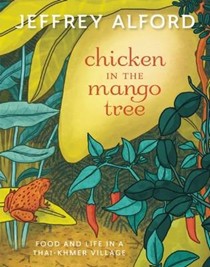Chicken in the Mango Tree by Jeffrey Alford
April 11, 2017 by Jenny Chicken in the Mango Tree: Food
and Life in a Thai-Khmer Village by Jeffrey Alford is part
memoir and part cookbook which documents his journey from Toronto
to Kravan, a small village in rural Thailand. He shares the journey
that led him to his new life in this village that he shares with
his partner, Pea, a talented forager, gardener and cook.
Chicken in the Mango Tree: Food
and Life in a Thai-Khmer Village by Jeffrey Alford is part
memoir and part cookbook which documents his journey from Toronto
to Kravan, a small village in rural Thailand. He shares the journey
that led him to his new life in this village that he shares with
his partner, Pea, a talented forager, gardener and cook.
The stories of village and family life surround each dish and also details how the food is meant to be eaten: as an elaborate dish in a wedding ceremony, a well-deserved break from the rice harvest, or just a comforting snack at the end of a hard day.

I have always been a fan of Alford’s books with his ex-wife, Naomi
Duguid and the way they conveyed the experiences they
shared through their travels. This story is equally as fascinating
and is one that I’m sure any lover of food and travel will
appreciate. I loved being transported to life in this village and
particularly enjoy the recipes that Alford has shared. It is
clearly evident to see why this book won a silver medal at the
2016 Taste Canada Awards Les Lauréats des Saveurs du
Canada.
Special thanks to the publisher for sharing this excerpt from the book along with a recipe. Be sure to head over to our contest page to enter our giveaway for two copies of this title open to members in the US and Canada.
Cold Season
This is “cold season” in Isaan, and for some reason cold season here always catches me by surprise. Daytime highs of 85F (29C) and evening lows of 60F (16C) are not what I would classify as cold, but as I write mid-morning I am wearing socks (one of the two pairs that I own), and this morning I wore a long-sleeve shirt (one of three). In the sun today it’s a normal late-December day-dry, bright and warm-but in the shade even I can feel a tiny chill: cold season!
Cold season is no joke to Pea, or to anyone else but me. Jackets come out, stocking caps, blue jeans, woolen scarves ad, granted, when riding the motorbike on the highway at 50 mph (80 kmph), a nice warm jacket feels pretty good. But the mysterious thing to me is that everyone catches a cold! Kids have runny noses. People come down with the flu. I’ve come to think that it’s all just what we get used to, and here right now people are cold. And like everywhere else in the world, weather is a constant topic of conversation. Now mai? (“Are you cold?”), I am asked at least once a day, wearing shorts and flip-flops. When I look surprised and say no, people shudder in disbelief.
Cold season is for most people, I think, the best time of the year (not for me, because I like rainy season). The rice has been cut, threshed and is safely stored or sold. There’s money from harvest, unlike most of the rest of the year, when rural people are living off credit.
Cold season is a time when people can look after chores they’ve been too busy to do, or simply take it easy for a while. Some farmers will put in a cash crop of awy (sugarcane) or mansaparong (manioc, or cassava). For Pea, cold season and hot season are the best times of the year to grow vegetables. In the rainy season, trees and rice grow beautifully, but for vegetables there are few that thrive. Many times the rain is just too powerful, either flooding the vegetables or just smashing them.
 It’s a wee bit cool these days, especially in
the morning on the motorbike. Pea bundles up to make her rounds,
setting up fish traps and checking others.
It’s a wee bit cool these days, especially in
the morning on the motorbike. Pea bundles up to make her rounds,
setting up fish traps and checking others.Categories
- All Posts (6940)
- Antipasto (2135)
- Author Articles (247)
- Book News (935)
- Cookbook Giveaways (983)
- Cookbook Lovers (257)
- Cooking Tips (109)
- Culinary News (299)
- Food Biz People (552)
- Food Online (791)
- Holidays & Celebrations (272)
- New Cookbooks (149)
- Recipes (1500)
- Shelf Life With Susie (231)
- What's New on EYB (133)
Archives
Latest Comments
- eliza on What foods do you look forward to the most for each season?
- kmwyman on Rooza by Nadiya Hussain – Cookbook Review and Giveaway
- Maryd8822 on The Golden Wok – Cookbook Giveaway
- Dendav on Danube Cookbook Review and Giveaway
- sanfrannative on Rooza by Nadiya Hussain – Cookbook Review and Giveaway
- darty on Danube Cookbook Review and Giveaway
- Atroyer7 on Danube Cookbook Review and Giveaway
- demomcook on What foods do you look forward to the most for each season?
- demomcook on Danube Cookbook Review and Giveaway
- Darcie on How cookbooks can help build resilience